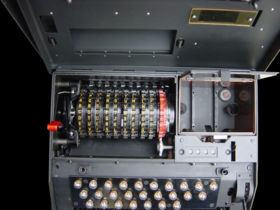
NEMA (machine)
Encyclopedia
In the history of cryptography
, the NEMA (NEue MAschine) ("new machine"), also designated the T-D (Tasten-Druecker-Maschine) ("key-stroke machine"), was a 10-wheel rotor machine
designed by the Swiss Army
during World War II
as a replacement for their Enigma machine
s.
 The Swiss became aware that their current machine, a commercial Enigma (the Swiss K), had been broken by both Allied and German cryptanalysts. A new design was begun between 1941 and 1943 by Captain Arthur Alder, a professor of mathematics
The Swiss became aware that their current machine, a commercial Enigma (the Swiss K), had been broken by both Allied and German cryptanalysts. A new design was begun between 1941 and 1943 by Captain Arthur Alder, a professor of mathematics
at the University of Bern. The team which designed the machine also included Professors Hugo Hadwiger
and Heinrich Emil Weber.
In the spring of 1944, the first prototype had become available. After some modifications, the design was accepted in March 1945, and production of 640 machines began the following month by Zellweger AG. The first machine entered service in 1947.
NEMA was declassified on 9 July 1992, and machines were offered for sale to the public on 4 May 1994.
s that control the stepping of the rotors and the reflector. The wheels are assembled on an axle
in pairs consisting of a drive wheel and an electrical rotor.
The NEMA machine weighs about 10 kg and measures approximately 36×32×14 cm.
History of cryptography
The history of cryptography begins thousands of years ago. Until recent decades, it has been the story of what might be called classic cryptography — that is, of methods of encryption that use pen and paper, or perhaps simple mechanical aids...
, the NEMA (NEue MAschine) ("new machine"), also designated the T-D (Tasten-Druecker-Maschine) ("key-stroke machine"), was a 10-wheel rotor machine
Rotor machine
In cryptography, a rotor machine is an electro-mechanical device used for encrypting and decrypting secret messages. Rotor machines were the cryptographic state-of-the-art for a prominent period of history; they were in widespread use in the 1920s–1970s...
designed by the Swiss Army
Military of Switzerland
The Swiss Armed Forces perform the roles of Switzerland's militia and regular army. Under the country's militia system, professional soldiers constitute about 5 percent of military personnel; the rest are male citizen conscripts 19 to 34 years old...
during World War II
World War II
World War II, or the Second World War , was a global conflict lasting from 1939 to 1945, involving most of the world's nations—including all of the great powers—eventually forming two opposing military alliances: the Allies and the Axis...
as a replacement for their Enigma machine
Enigma machine
An Enigma machine is any of a family of related electro-mechanical rotor cipher machines used for the encryption and decryption of secret messages. Enigma was invented by German engineer Arthur Scherbius at the end of World War I...
s.
History

Mathematics
Mathematics is the study of quantity, space, structure, and change. Mathematicians seek out patterns and formulate new conjectures. Mathematicians resolve the truth or falsity of conjectures by mathematical proofs, which are arguments sufficient to convince other mathematicians of their validity...
at the University of Bern. The team which designed the machine also included Professors Hugo Hadwiger
Hugo Hadwiger
Hugo Hadwiger was a Swiss mathematician, known for his work in geometry, combinatorics, and cryptography.-Biography:...
and Heinrich Emil Weber.
In the spring of 1944, the first prototype had become available. After some modifications, the design was accepted in March 1945, and production of 640 machines began the following month by Zellweger AG. The first machine entered service in 1947.
NEMA was declassified on 9 July 1992, and machines were offered for sale to the public on 4 May 1994.
The machine
NEMA uses 10 wheels, of which four are normal electrical rotors with 26 contacts at each end that are scramble wired in a way unique to each rotor type; one is an electrical reflector (like the Enigma's Umkehrwalze) with one set of 26 pairwise cross connected contacts; and the remaining five are "drive wheels", with mechanical camCam
A cam is a rotating or sliding piece in a mechanical linkage used especially in transforming rotary motion into linear motion or vice-versa. It is often a part of a rotating wheel or shaft that strikes a lever at one or more points on its circular path...
s that control the stepping of the rotors and the reflector. The wheels are assembled on an axle
Axle
An axle is a central shaft for a rotating wheel or gear. On wheeled vehicles, the axle may be fixed to the wheels, rotating with them, or fixed to its surroundings, with the wheels rotating around the axle. In the former case, bearings or bushings are provided at the mounting points where the axle...
in pairs consisting of a drive wheel and an electrical rotor.
The NEMA machine weighs about 10 kg and measures approximately 36×32×14 cm.
External links
- Frode Weierud's page on the NEMA — photographs and a simulator
- David Hamer's page on NEMA — includes records of NEMA selling prices: http://www.eclipse.net/~dhamer/enigma_p.htm
- Bob Lord's page on the NEMA — includes scanned manuals
- Jerry Proc's NEMA page

